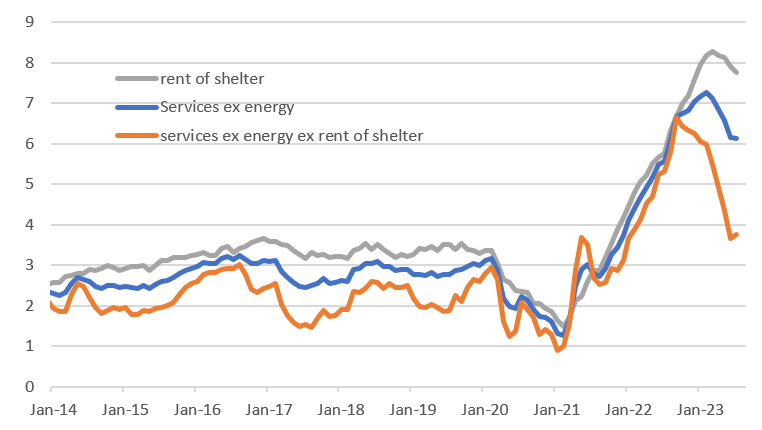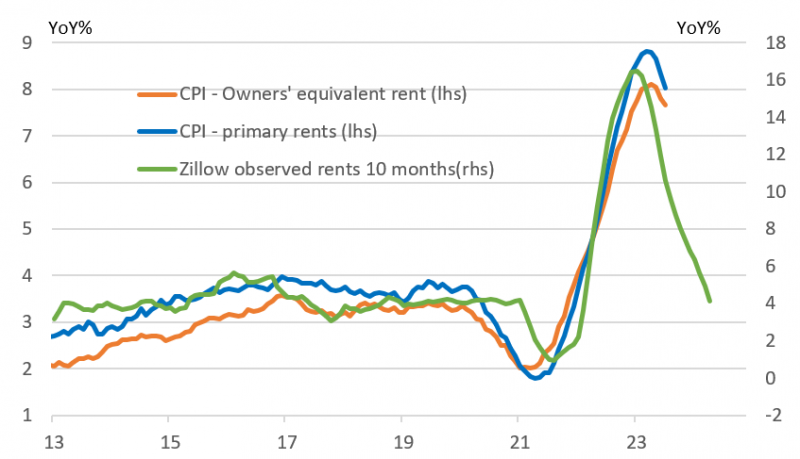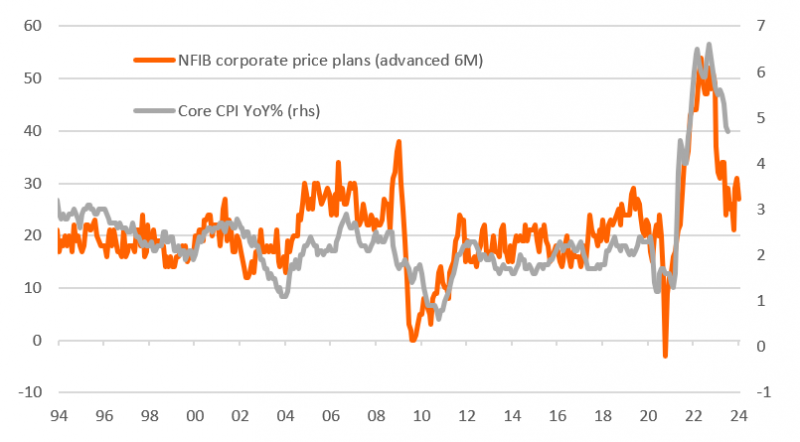U.S. Inflation Boosts Case For No Further Rate Hikes
A second consecutive benign set of inflation prints adds to optimism that the Fed rate hike cycle is at an end and a soft landing is achievable for the US economy. We continue to have our concerns about the economic outlook, centred on the abrupt hard stop in credit growth, but the Fed will soon be in a position to be able to cut rates if a recession materialises.

US inflation pressures continue to ease
The US consumer price inflation report showed that prices rose 0.2% month-on-month at both the headline and core (ex food and energy) level as was expected. To two decimal places it was even better at 0.17% and 0.16% respectively, which meant that the annual rate of headline inflation came in at 3.2% rather than 3.3% (versus 3% in June). Core inflation slowed to 4.7% from 4.8% as expected.
A decent drop in used car prices helped (-1.3% MoM), but a second consecutive large decline in air fares (-8.1%) is a bit of a surprise. With medical care (-0.2%), recreation (0.1%), education (0%) and other goods and services (0.1%) all very subdued the Federal Reserve has got to be pretty happy with this. That so-called 'supercore' services (services ex energy ex housing) looks like it comes in at around 0.2% MoM, although the year-on-year rate ticks higher a little due to base effects.
Supercore services on the right path (YoY%)

Macrobond, ING
Housing costs rose more than we thought though, with owners’ equivalent rent (the largest CPI component with a 25% weighting) rising 0.5% MoM/7.7% YoY but all in this report supports the nice golidlocks scenario of a slowdown in inflation allowing the Fed to stop hiking and eventually cut rates next year, which catches the slowing economy in time to prevent a recession. Obviously a lot can go wrong and we think it probably will given the worries about the abrupt slowdown in credit growth, but for now this data is encouraging.
Housing components of CPI set to slow in line with rents

Macrobond, ING
Headline may tick higher on energy but core will slow much further
Unfortunately, we are likely to see headline annual inflation rise further in YoY terms in August, albeit modestly. This will largely reflect higher energy costs, but we suspect it will resume its downward path again by October. Core inflation won't have this problem as the 0.6% MoM prints for August and September last year will drop out of the annual comparison to be replaced by 0.2% readings we predict, allowing annual core inflation to slow to below 4% by September.
This is going to be increasingly driven by the all-important housing components, which are set to slow sharply based on observed rents while used car prices are set to fall further based on auction prices. Consequently we are increasingly confident of a sub 3.5% YoY core CPI print by year-end. We had been hoping that headline inflation could be around 2.5%, but the rise in oil and gasoline prices over the last couple of months makes this look less achievable.
Higher energy costs can be viewed like a tax – no need for the Fed to hike further
In fact there has been some talk that the rise in energy costs will make the Fed more inclined to hike rates since it will push up inflation with rising costs potentially passed onto other components such as logistics and airline fares. We are not that concerned though since it can have a disinflationary effect elsewhere because higher energy prices can be viewed similarly to a tax. You can't avoid filling up your car with gasoline and you can't not heat your home etc so it effectively means you have less money at the end of the day to spend on other goods and services. It hurts economic activity and effectively intensifies disinflation in other components over time. As such the Fed will be watching and waiting to see what happens rather than any knee-jerk hike action.
NFIB survey points to weakening corporate pricing power and lower core CPI

Macrobond, ING
Moreover, business surveys continue to point to weakening pricing power, such as the ISM services index being consistent with 1% headline CPI and the National Federation of Independent Business survey pointing to core inflation heading to 3% by year-end. Such an inflation backdrop should allow the Fed to respond to any recession threat with interest rate cuts next year.
More By This Author:
The Commodities Feed: Supply Risks From Australia Push European Gas Prices HigherRates Spark: Energy And Food Inflation Is Ringing More Alarm Bells
FX Daily: Is Disinflation Enough To Get The Dollar Lower?
Disclaimer: This publication has been prepared by the Economic and Financial Analysis Division of ING Bank N.V. (“ING”) solely for information purposes without regard to any ...
more


